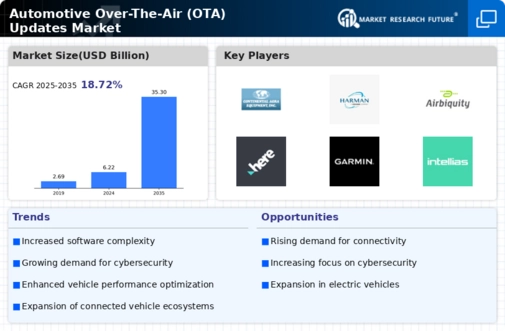Market Trends
Key Emerging Trends in the Automotive Over The Air Updates Market
As vehicles evolve into highly automated and software-dependent entities, the frequency of recalls has surged, driven by various faults, including software bugs. Recalls occur when automakers withdraw specific vehicle models from the market for thorough inspection and necessary repairs. These recalls can be categorized as either voluntary or influenced, with voluntary recalls initiated by auto manufacturers for the inspection of a specific vehicle model.
The period from 2013 to 2016 witnessed a substantial increase in voluntary recalls, underscoring the challenges posed by software vulnerabilities. In 2016, Chrysler, a prominent automobile manufacturer, recalled 1.4 million vehicles due to a potential vulnerability to hackable software. General Motors, another major player in the automotive industry, recalled nearly 4.3 million vehicles worldwide in the same year to address a software defect. Honda Motor Co., Ltd., based in Tokyo, recalled 350,000 vehicles due to a software issue affecting the electric parking brake. In 2015, AB Volvo recalled 59,000 cars across 40 markets to rectify a software fault that could temporarily shut down the engine.
The year 2016 marked a peak in recalls, particularly in the United States. During this year, one Original Equipment Manufacturer (OEM) recalled approximately 300,000 vehicles to address issues with their infotainment audio units, while another recalled 100,000 vehicles to fix faulty relays. Additionally, around 80,000 vehicles were recalled due to software bugs. The surge in voluntary recalls during this period emphasized the critical need for Over-the-Air (OTA) updates, which have the capability to address security concerns and rectify automotive glitches in the software.
Recalls incur substantial costs for automakers. According to a study conducted by AlixPartners in 2018, titled "The Auto Industry’s Growing Recall Problem—And How to Fix It," US-based OEMs and suppliers paid approximately USD 11.8 billion in claims in 2016. Additionally, they recorded USD 10.3 billion in warranty and recall accruals. In response to these escalating recall costs, automakers are increasingly adopting OTA updates as a strategic solution. These updates offer a proactive approach to addressing software-related issues and reducing the need for physical recalls.
OTA updates provide automakers with the capability to remotely update software in vehicles, tackling security vulnerabilities and addressing glitches without necessitating a visit to a service center. This not only streamlines the resolution process but also enhances customer satisfaction by minimizing disruptions and inconvenience associated with traditional recall procedures.
The adoption of OTA updates represents a significant step forward in mitigating the challenges posed by software-related faults in vehicles. By proactively addressing issues through remote updates, automakers can not only reduce the financial burden associated with recalls but also enhance the overall efficiency and safety of their vehicles. As the automotive industry continues to embrace advancements in software and connectivity, the importance of OTA updates is set to grow, driving the market's expansion and contributing to a more resilient and responsive automotive ecosystem.









Leave a Comment